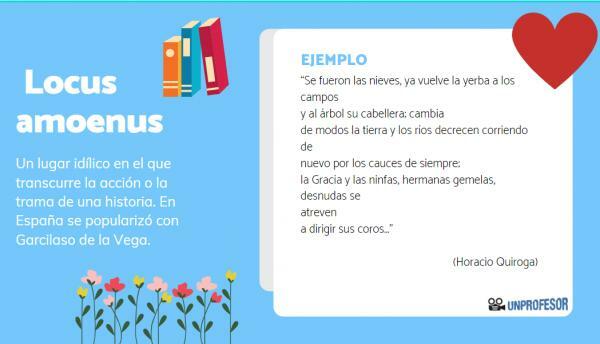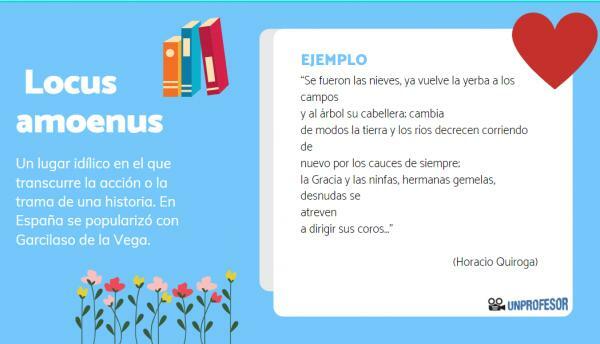Locus AMOENUS: meaning and examples

When we study the history of literature, we may come across literary topics like the locus amoenus, one of the most used during the Renaissance. The locus amoenus refers to a idyllic place in which the action or the plot of a story takes place; it is an idealized place where beauty, peace and tranquility abound. It can be compared to the garden of Eden or the lost paradise of the Catholic Bible, a space full of nature and beings that coexist in harmony. It is a topic widely used in Spanish literature and, therefore, in this lesson from a PROFESSOR we are going to discover the meaning of locus amoenus and examples of poems that have this topic of literature.
Index
- Locus Amoenus meaning: easy definition
- Literary topic of Locus Amoenus in the Renaissance
- Poets of the Locus Amoenus: Garcilaso, Fray Luis de León y Góngora
- Locus Amoenus Examples: Highlight Poems
Locus Amoenus meaning: easy definition.
To understand what the locus amoenus is we have to pay attention to its definition. If we go to the etymology, locus amoenus
It comes from the Latin and refers to a locus (place) what is it amoenus (pleasant, idyllic, beautiful, etc.). Therefore, we directly place ourselves in a space that appears to us as a perfect, relaxed and beautiful place, a perfect place to rest and enjoy life.But, in addition to the meaning of locus amoenus in its most strictly etymological sense, you should know that this concept is a topic of classical literature and that was used during the Middle Ages and, above all, the Renaissance. It was the ideal place chosen by the poets to place the characters of their creations and give them a perfect space for joy, enjoyment and love.
Origin of the locus amoenus and evolution
The origin of the locus amoenus is found in the Greek poets: authors such as Homer, Virgil or Theocritus they placed their protagonists in these ideal and dreamed spaces. It is interesting to see how the use of the locus amoenus appears totally reversed in Ovid's work "The metamorphosis": the author locates his characters in this space that, although it may seem calm and peaceful, ends up becoming a place full of violence.
In addition to ancient times, the use of the locus amoenus was very prominent in the Middle Ages, especially among the Spanish poet Gonzalo de Berceo and his work "Milagros de Nuestra Señora". Here, we have one of the greatest examples of this literary topic within the medieval spanish literature.
Another very prominent poet in the use of the topic locus amoenus was William Shakespeare. This English playwright located these spaces on the outskirts of cities, a place that was more linked to nature and that allowed people to explore that part more natural, authentic and animal. In Shakespeare, natural places used to be spaces in which passionate or erotic scenes took place. We see this clearly in his work "A Midsummer Night's Dream".

Image: Pinterest
Literary topic of Locus Amoenus in the Renaissance.
We have already commented that the locus amoenus was cultivated primarily during the Middle Ages and the Renaissance. However, in the Roman Empire we also find a large number of texts that are based on this literary topic. It was Petrarch the poet who managed to make this topic reach the Renaissance and that Spanish writers as prominent as Garcilaso de la Vega or Fray Luis de León will end up becoming the new growers of these idyllic spaces. literary.
Garcilaso de la Vega he was the first Spanish poet to use the locus amoenus in Spain and he did so through his Eclogues. Centuries later, during the Literary romanticism, this topic was updated and became wilder, more natural, more mysterious. The romantics gave a greater depth to the space and linked the natural enclaves with the emotions of the characters in his works.
In the 19th and contemporary literature, the locus amoenus was overturned within the urban world and, therefore, we find small "oases" located in the heart of the city that are the authors' favorite corners so that their characters can enjoy a quiet, intimate and ideal moment.
Locus amoenus vs. locus eremus
It is essential to contrast the two most frequent topics of the time: the locus amoenus and the eremus. The second refers to a inhospitable place, a remote place, a soulless place. These spaces are usually far from the city, far from civilization and, due to this distance from the cities, many authors placed their characters here to give free rein to their passions and their wishes.
Poets of the Locus Amoenus: Garcilaso, Fray Luis de León y Góngora.
Now that we know the meaning of locus amoenus, let's discover the main poets who cultivated this topic of literature. The most important was Garcilaso de la Vega in their Eclogues, but there are also other authors such as Fray Luis de León and Gongora who used this topic.
Garcilaso de la Vega
As we have already mentioned, Garcilaso was the first Spanish Renaissance poet to use the locus amoenus. In his Eclogues, he wrote poems that are part of the bucolic genre and whose protagonists are found in natural and idealized spaces. The bucolismo consisted of a classic tradition that also had a great importance during the XVI and that consisted of creating idealized plots and situations that took place in a perfect world. Influenced by Virgilio's "Bucólicas", Garcilaso's poems have that ideal and lyrical air that was reminiscent of the most classical beauty.
Fray Luis de Leon
This poet also cultivated the locus amoenus, especially in his work "Ode to retired life." But this author shows us a space quite different from the traditional one and the one presented by Garcilaso. Fray Luis de León places us in a natural space, but cultivated by man: an orchard. We are not, therefore, in the middle of wild and pure nature, but in an artificial nature created by man.
Gongora
He is another of the poets who also used the locus amoenus in his works, especially in "Fable of Polyphemus and Galatea". Let us remember that Góngora is a poet of the Baroque and, therefore, the style that he gives to this literary topic is slightly different. Here, we are detailed in detail what that space in which we find ourselves is like so that, in this way, we can mentally travel to the place recreated by the poet.
Locus Amoenus Examples: Outstanding Poems.
To conclude this lesson, we will end by putting some examples of locus amoenus from poems prepared by great authors who drew on this literary topic. Here are some of them:
Streams pure, crystalline waters,
trees that you are looking at in them,
green meadow full of cool shade,
birds that here you sow your quarrels,
ivy that you walk through the trees,
twisting his step through her green bosom:
I saw myself so alien
of the serious evil that I feel
that of pure contentment
with your loneliness I recreated,
where with sweet sleep he rested,
or with the thought it passed
where I could not find
but memories full of joy.
(Garcilaso de la Vega, Eclogue 1)
“The snows are gone, the grass is returning to the fields [and its hair to the tree; change
thus the land and the rivers decrease running [again through the usual channels;
Grace and the nymphs, twin sisters, naked [dare
to direct their choirs... "
(Horacio Quiroga)

If you want to read more articles similar to Locus amoenus: meaning and examples, we recommend that you enter our category of Literary concepts.
Bibliography
- Foresti, C. (1963). Descriptive schemes and tradition in Gonzalo de Berceo (locus amoenus-locus eremus). Philology Bulletin, (15), 5-31.
- de Ferraresi, A. C. (1974). Locus Amoenus and visionary garden in Reason for love. Hispanic Review, 173-183.



